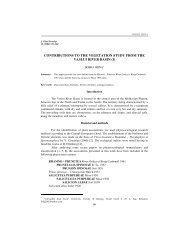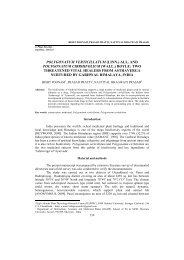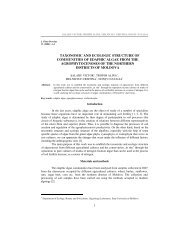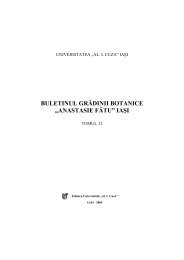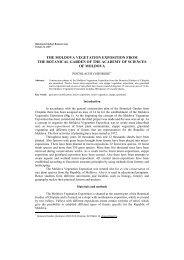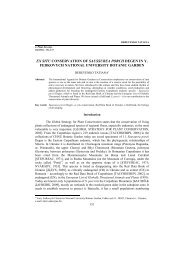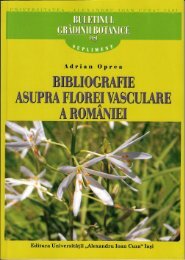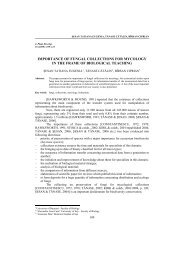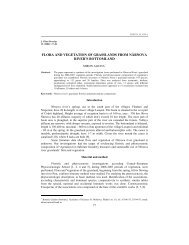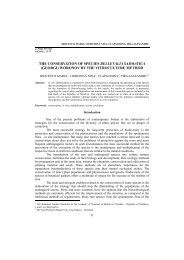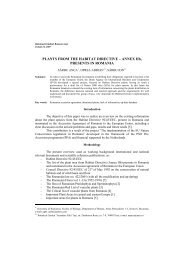trichoderma viride pers. - Journal of Plant Development
trichoderma viride pers. - Journal of Plant Development
trichoderma viride pers. - Journal of Plant Development
Create successful ePaper yourself
Turn your PDF publications into a flip-book with our unique Google optimized e-Paper software.
TRICHODERMA VIRIDE PERS. – EXPERIMENTAL MODEL FOR BIOLOGICAL AND …<br />
between 20-22ºC both growth and sporulation were favoured. At 37ºC the growth and<br />
sporulation <strong>of</strong> the T. <strong>viride</strong>, isolate Td 50 , were very well.<br />
Based on these investigations, it was possible to be established the optimal<br />
biological parameters for the development <strong>of</strong> T. <strong>viride</strong>, isolate Td 50 : (i) solid culture media:<br />
Weindling, Warcup, Malt extract agar, PDA; (ii) carbon sources: monosaccharides mannite,<br />
fructose, ribose, glucose, manose; (iii) nitrogen sources: peptone, aminoacids DL-leucine,<br />
L-cistine, DL-citruline, DL-nor-leucine, ammonium nitrate and tartrates salts; (iv) pH initial<br />
values <strong>of</strong> culture media: 4.0-5.5 (for growth), 4.0-8.5 (for biomass); (v) temperatures:<br />
optimum 26ºC, for growth 24-32ºC, for sporulation 20-22ºC.<br />
2 – Evaluation and experimental verifying <strong>of</strong> the mass multiplication ability<br />
<strong>of</strong> antagonistic T. <strong>viride</strong> fungi on the culture media in order to select the optimum<br />
industrial culture substrate (medium).<br />
In the submerged cultivation <strong>of</strong> T. <strong>viride</strong> on nine liquid media, some <strong>of</strong> which<br />
contained intermediate products from the food commodity industry, the best growth was<br />
obtained on beer must (mB), on the Weindling medium with the imported chemically pure<br />
glucose (WG) or with indigenous food glucose (Wg) and on the MPB medium (Fig. 7.).<br />
100<br />
80<br />
60<br />
40<br />
20<br />
0<br />
PDA200<br />
PDA500<br />
C+M<br />
P<br />
mB<br />
MP<br />
MBP<br />
Wg<br />
WG<br />
(CONTROL)<br />
Nutrients g d.s. Biomass g d.s. Efficiency %<br />
Fig. 7. Accumulation <strong>of</strong> biomass (g. dry substance/ d.s.) and efficiency (%) <strong>of</strong> culture liquid media by<br />
Trichoderma <strong>viride</strong>, isolate Td 50<br />
On these media the sporulation and the titre <strong>of</strong> conidia and chlamidospores were<br />
high. The highest quantity <strong>of</strong> dry biomass was obtained and a better use (70.0-84.863%) <strong>of</strong><br />
the nutrients from the medium was recorded. Data <strong>of</strong> optic density <strong>of</strong> the T. <strong>viride</strong> liquid<br />
cultures confirm this (Fig. 8.).<br />
3000<br />
0 hrs. 96 hrs.<br />
2500<br />
2000<br />
1500<br />
1000<br />
500<br />
0<br />
Td50/<br />
PDA200<br />
Td50/<br />
PDA500<br />
Td50/ C+M Td50/ P Td50/ mB Td50/ MP Td50/ MBP Td50/ Wg Td50/ WG<br />
(CONTROL)<br />
Fig. 8. Optic density <strong>of</strong> Trichoderma <strong>viride</strong>, isolate Td 50 , cultivated on different liquid agitated media<br />
54



